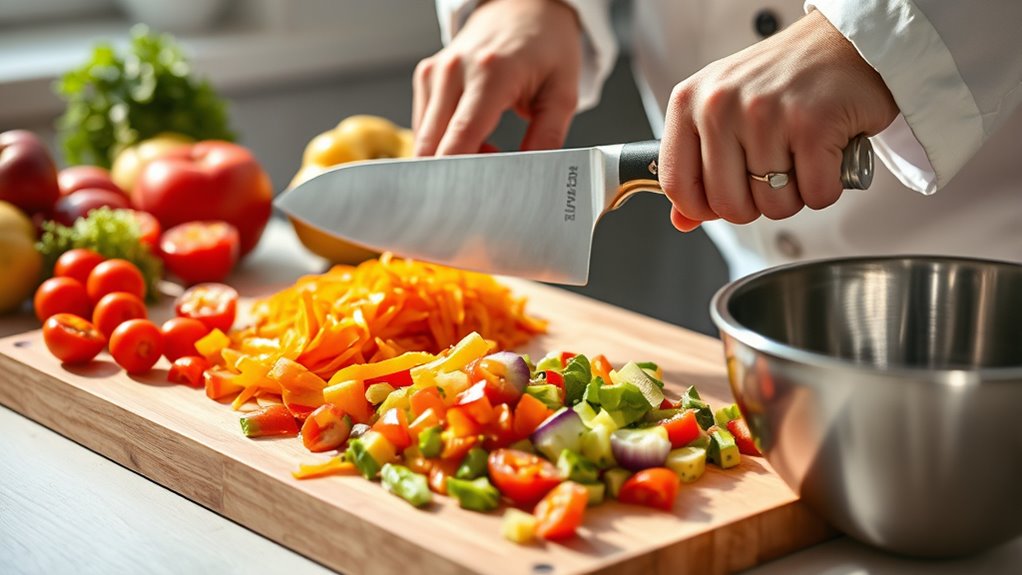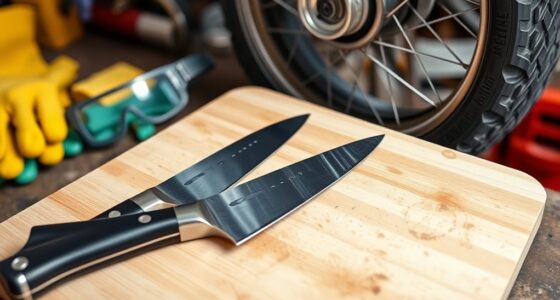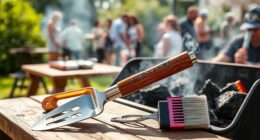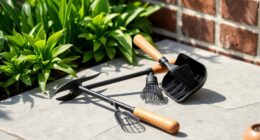To cut and serve like a pro, choose the right, sharp knives with comfortable handles, and always use stable cutting surfaces to prevent slips. Practice safe techniques, like curling fingers into a claw, and handle blades carefully to avoid injury. Keep tools sharp, store them properly, and wear safety gear such as gloves and goggles. Maintaining cleanliness and organization helps prevent cross-contamination. If you explore these safety tips further, you’ll master professional-level food prep with confidence.
Key Takeaways
- Select ergonomic, sharp knives and maintain their edge with proper sharpening tools to ensure safety and efficiency.
- Use proper cutting techniques, including a claw grip and rocking motion, to prevent injuries.
- Always cut on stable surfaces, separate cutting boards by food type, and sanitize thoroughly after use.
- Wear safety gear like cut-resistant gloves and slip-resistant shoes; keep first aid supplies accessible.
- Regularly inspect and replace tools and surfaces to uphold hygiene standards and prevent accidents.
Choosing the Right Cutting Tools for Your Kitchen
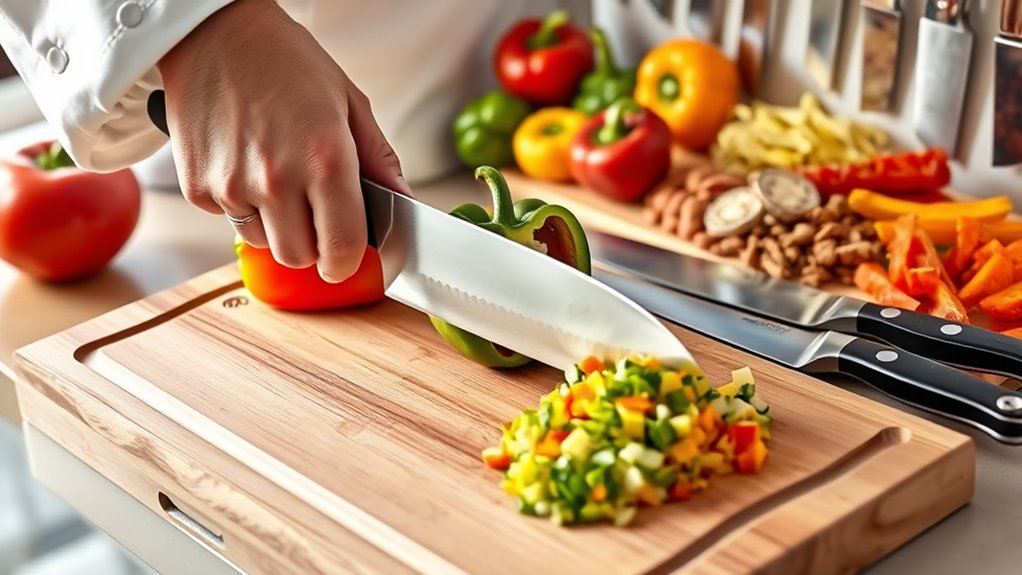
Choosing the right cutting tools is essential for safe and efficient food prep. Your choice of knives should prioritize knife ergonomics, ensuring a comfortable grip that reduces fatigue and improves control. Look for handles that fit well in your hand and feel balanced during use. Additionally, consider cutting surface materials, as they impact both safety and blade longevity. Wooden cutting boards are gentle on blades but require regular maintenance, while plastic surfaces are easy to sanitize and durable. Avoid glass or stone surfaces, which can dull your knives quickly and pose safety risks. Selecting the appropriate tools based on these factors helps you cut confidently, reduces accidents, and keeps your blades sharp longer. Proper tool selection is the foundation of a safe, effective kitchen. Hybrid Bicycle
Proper Techniques for Safe and Efficient Cutting
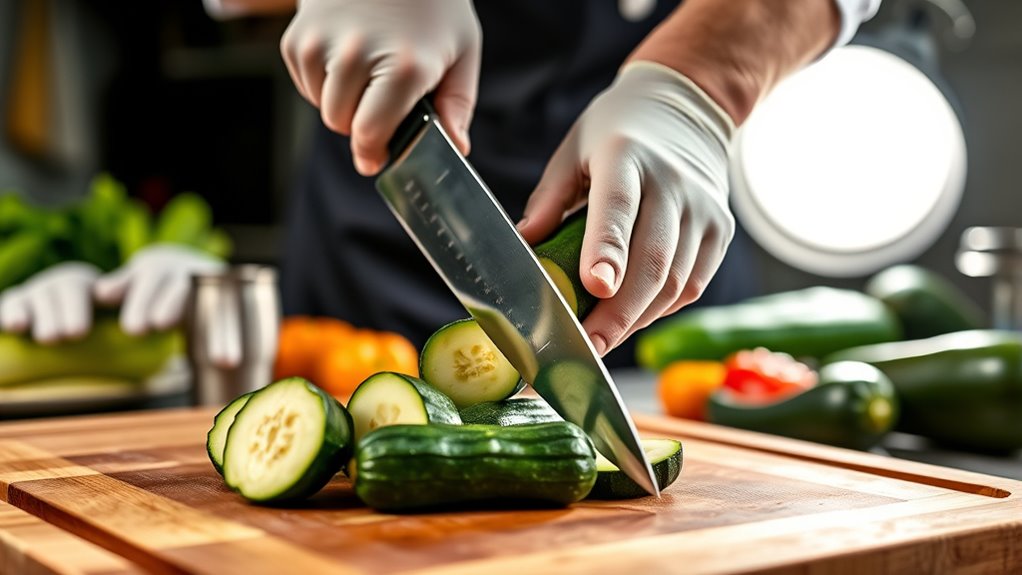
Mastering proper cutting techniques is crucial for ensuring safety and efficiency in the kitchen. Start with a firm yet comfortable knife grip, wrapping your fingers around the handle and placing your thumb on the side for control. Keep your guiding hand in a claw shape, curling your fingertips inward to protect them from the blade. When making a cutting motion, use a smooth, rocking motion, pivoting the knife on the tip while applying even pressure. Maintain a steady rhythm, focusing on precision rather than force. Always cut on a stable surface, and ensure your knife is aligned with your target. Proper knife handling not only improves safety but also enhances your overall cutting technique. By adopting these techniques, you reduce the risk of injury and speed up your prep work, making your kitchen tasks safer and more efficient.
Maintaining Sharpness: When and How to Sharpen Your Knives
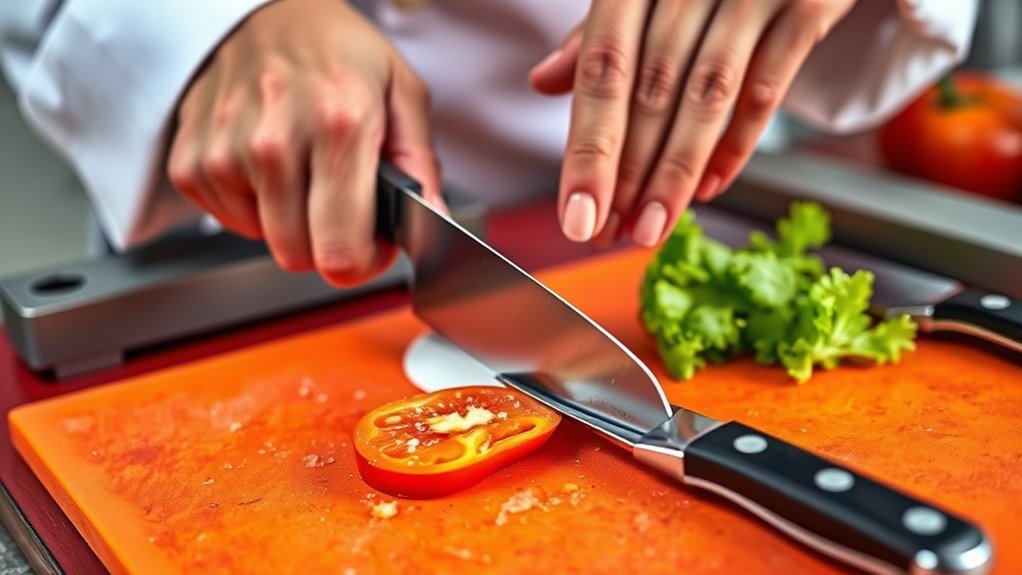
You’ll know it’s time to sharpen your knives when they start tearing through food or require more effort. Using the right tools, like a whetstone or honing rod, makes all the difference in maintaining a sharp edge. Mastering proper sharpening techniques guarantees your knives stay effective and safe to use. Regular maintenance and understanding best practices ensures longevity and optimal performance of your cutlery.
Signs of Dullness
A dull knife can quickly turn meal prep into a frustrating and dangerous task. You’ll notice dull blades struggle to cut through food smoothly, requiring more pressure and increasing the risk of slips. Blunt edges often cause your slices to tear or crush ingredients instead of cleanly slicing them. If you find yourself pressing harder or the knife slipping off the surface, it’s a clear sign the blade needs attention. Additionally, uneven or jagged cuts indicate dullness. You might also feel more fatigue in your hand after chopping for a while. Recognizing these signs early helps prevent accidents and ensures your knives perform safely and efficiently. Regularly checking for dull blades keeps your kitchen tasks precise, safe, and enjoyable. Keeping your knives sharp also reduces the risk of skin damage from applying excessive force.
Proper Sharpening Tools
To keep your knives sharp and performing at their best, it’s vital to choose the right sharpening tools. Quality blade maintenance starts with selecting effective sharpening systems, whether honing rods, whetstones, or electric sharpeners. Each tool serves a different purpose and skill level, so pick one suited to your needs. Honing rods are great for quick realignment, while whetstones offer precise edge restoration. Electric sharpeners are convenient for regular upkeep but can be aggressive if used improperly. Investing in the right sharpening system ensures your blades stay sharp longer and reduces the risk of damage. Proper selection of your tools simplifies blade maintenance, keeps your knives in top shape, and guarantees safer, more efficient cutting.
Sharpening Technique Tips
Maintaining sharp knives requires knowing not just how to sharpen, but also when to do it. You should sharpen your knife when it starts to drag or require extra pressure, usually after several uses. Proper knife ergonomics, like a comfortable grip and balanced weight, help you control the blade during sharpening. Follow a consistent sharpening frequency—typically once every few months or when you notice dullness—to keep your knife performing its best. Use the correct technique: keep the blade at a consistent angle, usually 15-20 degrees, and use smooth, even strokes. Avoid applying excessive force; let the sharpening tool do the work. Regularly checking your knife’s edge and maintaining proper ergonomics will guarantee sharpness and safety in your kitchen. Being aware of passive voice detection can also improve the clarity of your instructions and safety guidelines.
Safe Handling and Storage of Kitchen Blades
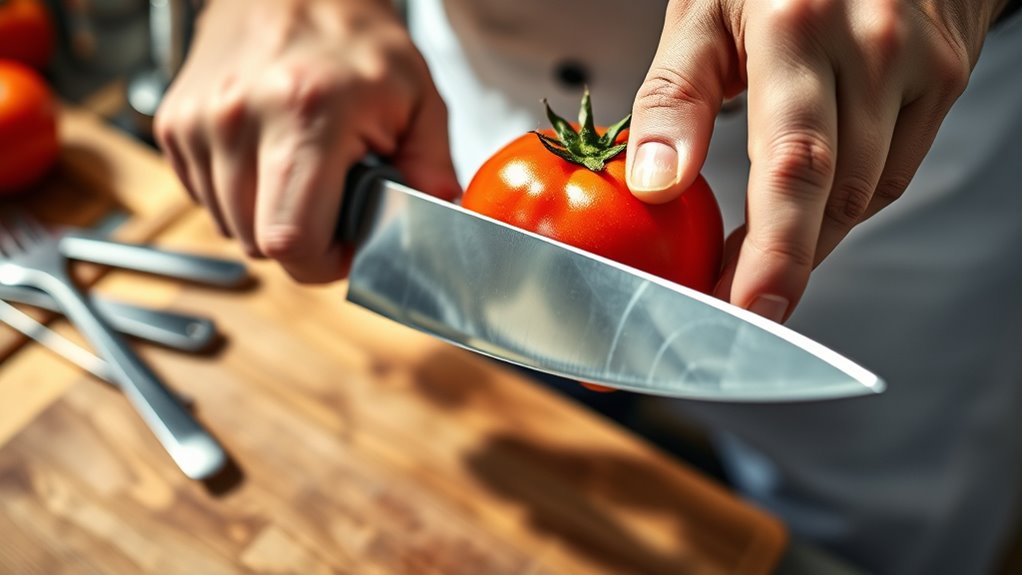
Ever wondered how to keep your kitchen blades safe and in top condition? Proper knife storage is key to maintaining blade safety and preventing accidents. Store knives in a designated knife block, magnetic strip, or protective sheaths—never loose in drawers. This prevents dulling and reduces the risk of cuts when reaching for a knife. Always handle blades carefully, avoiding unnecessary contact with the sharp edge. When not in use, ensure knives are clean, dry, and stored securely. Using a dedicated storage solution keeps blades protected and organized, making it easier to grab the right tool safely. Proper water safety practices, such as keeping blades dry and rust-free, help prolong the life of your knives. Remember, proper knife storage not only prolongs the life of your blades but also keeps your kitchen safe for everyone. Prioritize safety and maintenance by storing your knives correctly.
Recognizing and Preventing Common Cutting Injuries
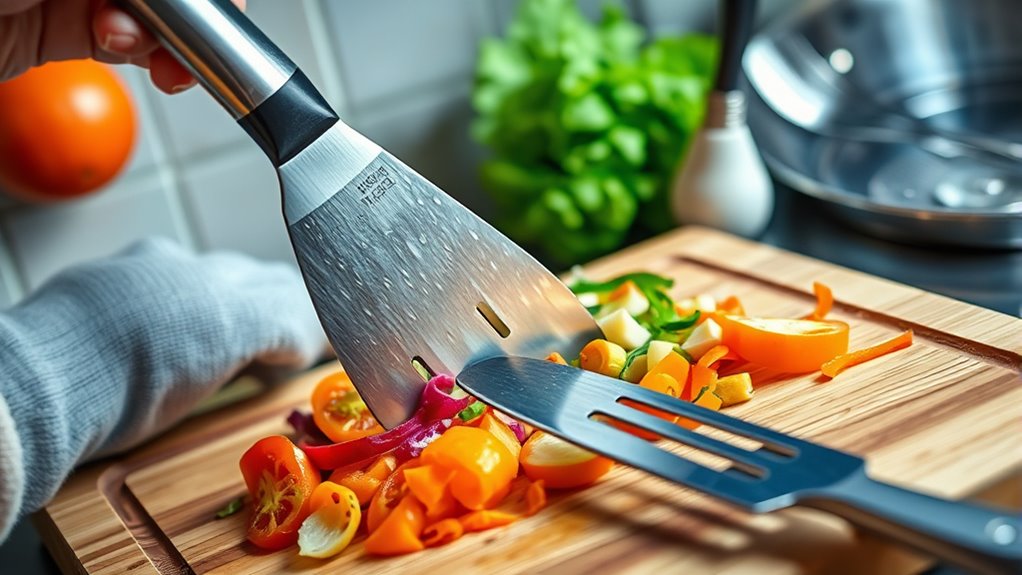
Recognizing the signs of common cutting injuries is essential for preventing serious accidents in the kitchen. If you notice a sudden sharp pain, bleeding, or swelling after a cut, stop immediately. Pay attention to your knife grip—holding the knife too loosely or with a poor grip can cause slips that lead to injuries. Always maintain control by gripping the handle firmly and keeping your fingers tucked away. Your cutting surface also plays a role; a stable, non-slip surface reduces the risk of the knife slipping. Watch for any signs of fatigue or distraction, which can cause careless cuts. By staying alert and adjusting your technique, you can prevent most common cutting injuries and keep your kitchen safe.
Cleaning and Sanitizing Your Cutting Tools

To guarantee your cutting tools stay safe and effective, it’s essential to clean and sanitize them properly after each use. Follow strict sanitizing practices to prevent bacteria buildup and cross-contamination. Develop a consistent cleaning schedule to ensure tools are thoroughly washed, dried, and sanitized at regular intervals. Use hot water and dish soap to remove debris, then apply a food-safe sanitizer to kill any remaining germs. Pay attention to blades, handles, and edges, making sure no residue remains. Proper cleaning not only prolongs your tools’ lifespan but also maintains food safety standards. Always dry tools completely before storing to prevent rust. Incorporate these cleaning practices into your routine, and your cutting tools will stay sharp, safe, and ready for every task. Additionally, understanding proper aer purifier maintenance can help improve the overall environment where food is prepared, ensuring a healthier space.
Using Cutting Boards Correctly to Avoid Cross-Contamination
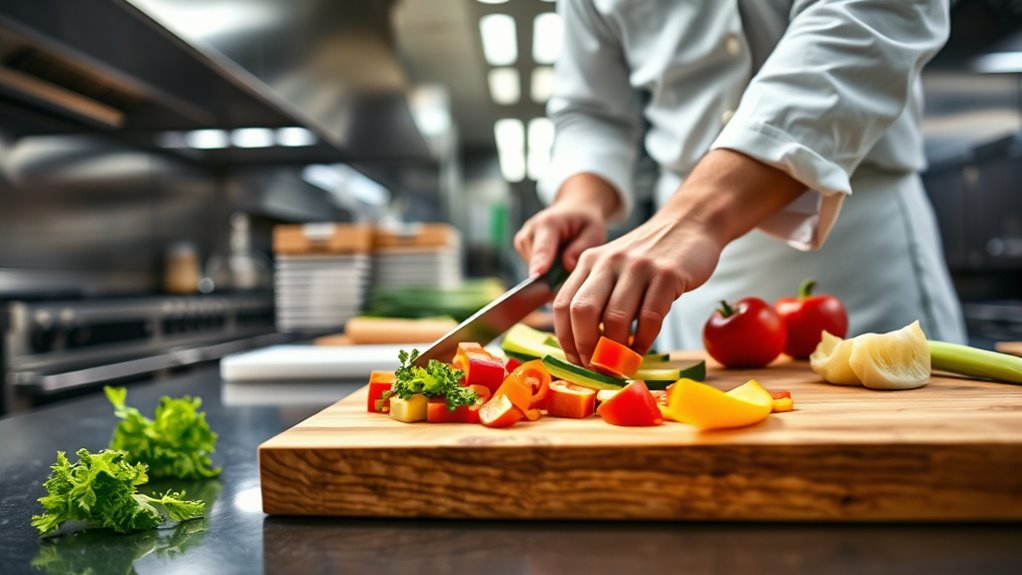
Using cutting boards correctly is essential to prevent cross-contamination in your kitchen. Choosing the right cutting board material is key—plastic, wood, or composite each have pros and cons for cross contamination prevention. To stay safe, follow these steps:
- Use separate cutting boards for raw meats, vegetables, and cooked foods.
- Label or color-code boards to easily identify their use.
- Wash and sanitize boards thoroughly after each use.
- Replace boards with deep grooves or cracks that harbor bacteria.
Proper Way to Serve and Present Your Dishes
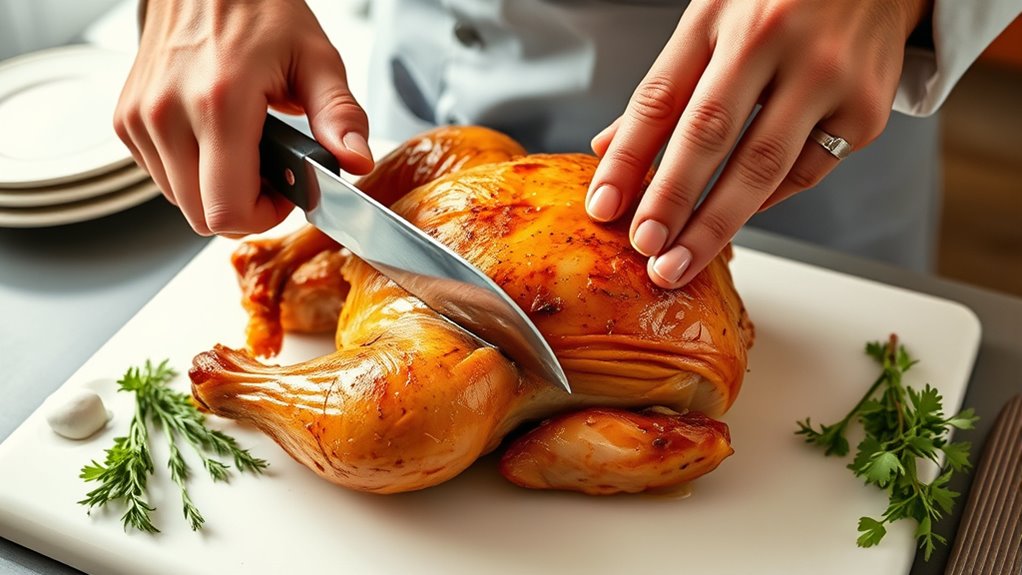
When serving your dishes, focus on elegant plating techniques that enhance visual appeal and make your food look tempting. Always follow safe serving practices to prevent contamination and make certain your guests’ safety. Mastering these skills will elevate your presentation and leave a lasting impression. Additionally, incorporating cozy textiles such as cloth napkins or placemats can add a warm touch to your table setting.
Elegant Plating Techniques
Elegant plating transforms a simple dish into a visual masterpiece, capturing your guests’ attention from the first glance. To achieve stunning plating presentation, focus on clean lines and balanced composition. Use garnishing techniques to add color, texture, and elegance, enhancing the dish’s appeal. Here are four tips to elevate your plating skills:
- Arrange components thoughtfully, creating height and depth for visual interest.
- Use negative space strategically to highlight the main elements.
- Incorporate fresh herbs or edible flowers for vibrant, natural accents.
- Keep sauces and drizzles neat, avoiding clutter and mess.
Mastering these techniques ensures your dishes look as good as they taste, impressing guests and elevating your culinary presentation.
Safe Serving Practices
To guarantee your dishes are both appealing and safe to eat, proper serving practices are essential. You should always verify your food storage is correct to prevent contamination, and your kitchen organization promotes efficiency. When serving, use clean utensils and plates, avoiding cross-contamination. Keep hot foods hot and cold foods cold, following food safety guidelines. Proper presentation enhances the dining experience and shows respect for your guests. Here’s a quick checklist:
| Tip | Reason |
|---|---|
| Use clean utensils | Prevents bacterial transfer |
| Serve at correct temps | Ensures food safety and quality |
| Keep food covered | Protects from contaminants |
| Maintain kitchen order | Simplifies safe handling and serving |
Additionally, paying attention to wall organization systems can streamline your serving area, making it easier to maintain hygiene and safety standards.
Following these practices helps you serve confidently and safely.
Essential Safety Gear and Equipment for Kitchen Safety
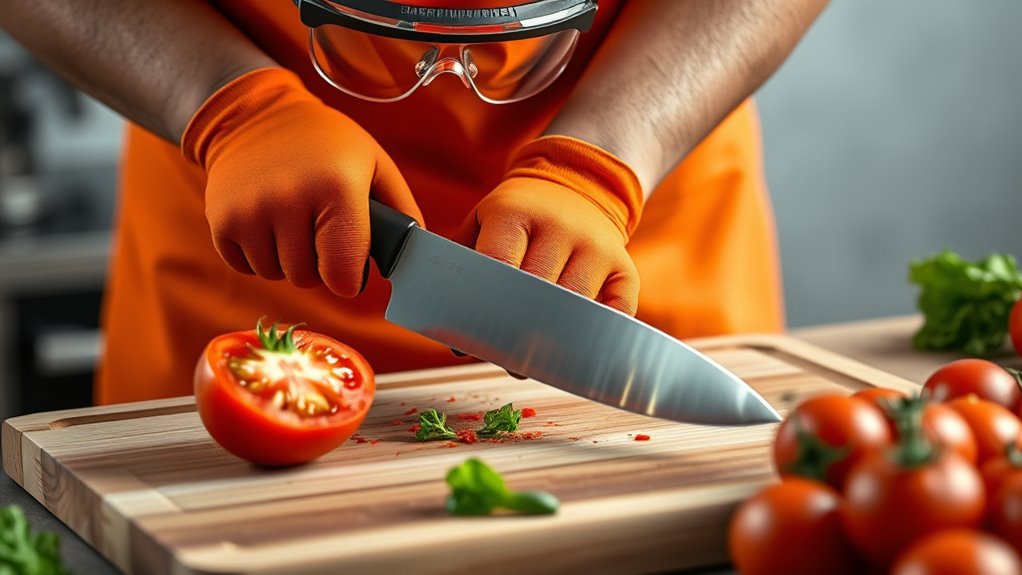
Having the right safety gear is essential for preventing accidents and injuries in the kitchen. Personal protective equipment keeps you safe during cutting, serving, and cleaning tasks. Being prepared with proper gear also supports first aid preparedness if an incident occurs. Here are four key items you should always have on hand:
- Cut-resistant gloves – protect your hands from accidental cuts.
- Safety goggles – shield your eyes from splashes and flying debris.
- Slip-resistant shoes – prevent falls on slick surfaces.
- First aid kit – respond quickly to cuts, burns, or other injuries.
Using this safety gear helps you work confidently and responsibly, reducing risks and ensuring a safer kitchen environment. Always prioritize safety to keep accidents at bay and be ready to handle emergencies effectively. Proper personal protective equipment can also improve overall work efficiency and safety awareness in the kitchen.
Frequently Asked Questions
How Often Should I Replace My Kitchen Knives for Safety?
You should replace your kitchen knives every 5 to 10 years for safety, depending on knife longevity and blade maintenance. If your blades become dull, chipped, or lose sharpness despite regular honing, it’s time to replace them. Proper care, like hand washing and storing them correctly, extends their lifespan. Regularly assess your knives, and don’t hesitate to upgrade when blade maintenance no longer restores their performance or safety.
What Are Signs My Cutting Tools Need Professional Sharpening?
You’ll know your cutting tools need professional sharpening when the blade dullness becomes noticeable, making cuts harder and more dangerous. Look for uneven edge wear, which indicates the blade isn’t cutting smoothly and needs expert attention. If you find yourself applying excessive pressure or the knife slips easily, it’s time to seek professional sharpening. Keep your blades in top shape to ensure safety and effortless cutting every time.
Can Using the Wrong Cutting Technique Cause Long-Term Injuries?
Yes, using the wrong cutting technique can cause long-term injuries. When you don’t maintain a proper grip or use the correct cutting angle, you risk straining muscles or damaging tendons over time. Always make certain you have a secure grip and adjust your cutting angle to match the task. This helps prevent repetitive stress injuries and keeps you safe while working, making your cuts more precise and efficient.
How Do I Prevent Cross-Contamination When Switching Cutting Tasks?
To prevent cross-contamination when switching cutting tasks, always wash your hands thoroughly and sanitize your cutting boards and knives between uses. Use separate utensils for different food allergens and label each station clearly. Follow proper sanitation practices to keep surfaces clean. This reduces the risk of transferring allergens or bacteria, ensuring food safety and protecting those with food allergies. Consistent hygiene is key to safe, professional food preparation.
What Safety Measures Are Recommended for Handling Broken Blades?
When handling broken blades, you gotta be extra careful—don’t let a blade injury turn into a disaster. Always wear protective gear like cut-resistant gloves and eye protection to shield yourself. Use tongs or a brush to pick up broken pieces instead of your hands. Dispose of broken blades in a designated sharps container immediately. Remember, safety is no accident; taking these precautions keeps you safe and your workspace accident-free.
Conclusion
By mastering these cutting and serving techniques, you’ll work confidently and safely in your kitchen. Remember, a sharp knife and proper safety habits aren’t just about efficiency—they’re about preventing accidents. Are you ready to elevate your culinary skills and serve like a pro? Keep practicing, stay cautious, and enjoy the process of creating beautifully prepared dishes with safety at the forefront. Your kitchen safety journey starts now!
